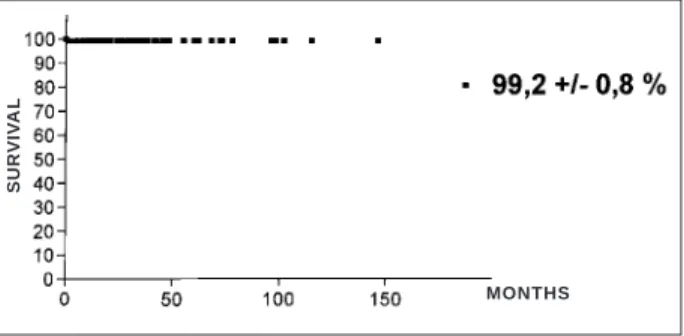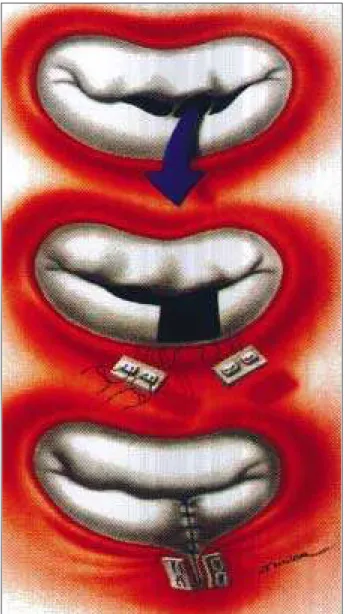Arq Bras Cardiol volume 73, (nº 3), 1999
Pomerantzeff et al. Mitral valve repair
2 7 7
Instituto do Coração of the Hospital das Clínicas – FMUSP
Mailing address: Pablo M. A. Pomerantzeff – Incor - Av. Dr. Enéas C. Aguiar, 44 - 05403-000 - São Paulo, SP Brazil.
Received on 12/17/983 Accepted on 1/29/99
Objective – To analyze the immediate and late results of
mitral valve repair with quadrangular resection of the poste-rior leaflet without the use of a prosthetic ring annuloplasty.
Methods - Using this technique, 118 patients with
mitral valve prolapse who underwent mitral repair from January ’84 through December ’96 were studied. Age ran-ged from 30 to 86 (mean = 59.1±11.8) years and 62.7% were males. An associated surgery was performed in 22% of the patients, and coronary artery bypass graft was the most frequently performed surgery (15 patients – 12.7%). In 20 (16.9%) patients other associated techniques of mitral valve repair were used and shortening of elongated chordae tendineae was the most frequent one (6 patients).
Results – Immediate mortality was 0.9% (one patient).
Long-term rates for thromboembolism, endocarditis, re-operation and death in the late postoperative period were 0.4%, 0.4%, 1.7% and 2.2% patients/year, respectively. The actuarial curve of survival was 83.8±8.6% over 12 years; survival free from re-operation was 91.8±4.3%, free from en-docarditis was 99.2±0.8% and free from thromboembolism was 99.2±0.8%. In the late postoperative period, 93.8% of the patients were in functional class 1 (NYHA), with a com-plete follow-up in 89.7% of the patients.
Conclusion – Patients with mitral valve prolapse
who undergo mitral valve repair using this technique have a satisfactory prognosis over 12 years.
Key words: mitral valve repair, valvular surgery, mitral annuloplasty
Arq Bras Cardiol, volume 73 (nº 3), 277-280, 1999
Pablo Maria Alberto Pomerantzeff, Carlos Manuel de Almeida Brandão, Eduardo Giusti Rossi, LuísFrancisco Cardoso, Flávio Tarasoutchi, Max Grinberg, Noedir Antonio Groppo Stolf,
Luiz Boro Puig, Geraldo Verginelli, Adib Domingos Jatene
São Paulo, SP - Brazil
Mitral Valve Repair. Quadrangular Resection of the Posterior
Leaflet in Patients with Myxomatous Degeneration
Original Article
Merendino et al 1 were the first to propose plication of
the mitral ring for correction of mitral regurgitation seconda-ry to rheumatic disease. Other authors have used the same technique in myxomatous degeneration or fibroelastic di-sease, with good results 2-5.
Most surgeons use this technique associated with the implant of a prosthetic ring. We performed a quadrangular resection of the posterior leaflet without annuloplasty with a prosthetic ring in 118 patients, and decided to analyze the late follow-up of this technique.
Methods
At the Instituto do Coração of the São Paulo University in Brazil, from January ’84 through December ’96, 118 patients underwent mitral valve repair with quadrangular resection of the posterior leaflet for correction of mitral regurgitation secondary to prolapse with myxomatous degeneration.
Seventy-four patients (62.7%) were males, and 44 (37.3%) were females. Age ranged from 30 to 86 years (mean age = 59.1±11.8). Twenty-five patients (21.2%) had asso-ciated problems: coronary artery disease in 15 (12.7%), tri-cuspid regurgitation in 5 (4.2%), aortic regurgitation in 3 (2.5%), aortic stenosis in 2 (1.7%) and an atrial septal defect in 2 (1.7%).
The technique used for mitral valve repair was the qua-drangular resection of the posterior leaflet, segmental annuloplasty and border-to-border suture of the leaflet, without the use of a prosthetic ring. A careful examination of the valve during surgery was essential. Plication of the ring was performed so as to eliminate tension on the suture of the leaflet. Associated techniques were used in 20 patients (table I). The method used for myocardial protection was fil-trated crystalloid cardioplegia (St. Thomas solution).
2 7 8
Pomerantzeff et al. Mitral valve repair
Arq Bras Cardiol volume 73, (nº 3), 1999
replacement in 3 (2.5%), plasty of the atrial septum in 2 (1.7%) and aortic commissurotomy in one (0.9%).
Thirty-two patients (27.1%) were in preoperative func-tional class IV (NYHA), 68 (57.6%) in funcfunc-tional class III and 18 (15.3%) in functional class II.
Follow-up data were obtained during medical appoint-ments, interviews by telephone or by questionnaire.
Data are presented according to the recommendations of the literature 6. Survival curves and event-free survival
curves were calculated according to the Kaplan-Meier method 7. Survival rates are presented as percentages of
patients per year (% patient/year).
Results
There was one death in the hospital (0.9%). This patient, on the 27th post-operative day, presented with acute
mitral regurgitation and underwent mitral valve replacement. He died seven days later of low cardiac output. Postoperati-ve complications happened in 8 patients: one (0.9%) had a
cerebral stroke, one (0.9%) endocarditis, three (2.5%) low cardiac output, one (0.9%) pneumonia, one (0.9%) acute re-nal failure and one (0.9%) acute mitral regurgitation.
Follow-up was complete in 89.7% of the patients. Three patients were re-operated upon in the late follow-up due to mitral regurgitation, with a mean interval of 25 months. There were five late deaths (4.3%), and the main cause of death was congestive heart failure in two patients (1.7%). Other causes of death were: arrhythmias in one (0.9%), stroke in one (0.9%) colon carcinoma in one (0.9%). Survival was 83.8±8.6% over 12 years (fig. 1). Survival free from re-operation was 91.8±4.3% (fig. 2), free from endo-carditis 99.2±0.8% (fig. 3) and free from thromboembolism 99.2±0.8% (fig. 4).
In the late postoperative follow-up, 93.8% of the patients were in functional class I (NYHA).
Discussion
Reconstruction of the mitral valve in myxomatous de-generation with ruptured or elongated cords of the posterior leaflet is possible in the majority of patients. Good results of mitral valve repair depend on good knowledge of the valve anatomy and detailed examination of the valve during surgery, aiming at detecting areas of prolapse, sites of retraction and jet lesions on the left atrium wall.
The technique of plication of the segment of the leaflet without support was described in 1960 8. Triangular or
quadrangular resections of these leaflet segments have been proposed 9,10. We believe that quadrangular resection of the
posterior leaflet must always be associated with a segmental
Table 1- Techniques associated with mitral valve repair
Associated techniques Patients %
Shortening of chordae tendineae 6 5.1
Calcium resection 6 5.1
Plication of the anterior leaflet 3 2.5 Sliding of the posterior leaflet 3 2.5 Resection of the anterior leaflet 1 0.9 Shortening of the papillary muscles 1 0.9 Resection of short chordae tendineae 1 0.9
Total 20 16.9
Fig. 1 – Survival actuarial curve during a 12-year follow-up in patients with myxomatous degeneration who underwent mitral valve repair.
SURV
IV
A
L
MONTHS
Fig. 2 – Survival free from re-operation.
SURV
IV
A
L
MONTHS
Fig. 3 – Survival free from endocarditis.
SURV
IV
A
L
MONTHS
Fig. 4 – Survival free from thromboembolism.
SURV
IV
A
L
Arq Bras Cardiol volume 73, (nº 3), 1999
Pomerantzeff et al. Mitral valve repair
2 7 9
Fig. 5 – Quadrangular resection of the posterior leaflet.
1. Merendino KA, Thomas GI, Jesseph JE, Herron PW, Winterscheid LC, Vetto RR. The open correction of rheumatic mitral regurgitation and or stenosis with special reference to regurgitation treated by posteromedial annuloplasty utilizing a pump-oxigenator. Ann Surg. 1959; 150: 5-22.
2. Carpentier A, Relland J, Deloche A, et al. Conservative management of the prolapsed mitral valve. Ann Thorac Surg 1978; 26: 294-302.
3. Alvarez JM, Teoh N, Deal CW. Repairing the degenerative anterior mitral leaflet. Ann Thorac Surg 1992; 54: 1229-30.
4. David TE, Armstrong S, Sun Z, Daniel L. Late results of mitral valve repair for mitral regurgitation due to degenerative disease. Ann Thorac Surg 1993; 56: 7-14.
5. Yacoub M, Halim M, Radley-Smith R, McKay R, Nuveld A, Towers M. Surgical treatment of mitral regurgitation caused by floppy valves: repair versus replacement. Circulation 1981; 64: II210-6.
References
6. Edmunds LH, Clark RE, Cohn LH, Grunkenmeier GL, Miller C, Weisel RD. Guidelines for reporting morbidity and mortality after cardiac valvular opera-tions. J Thorac Cardiovasc Surg 1996; 112: 708-11.
7. Anderson RP, Bonchek LI, Grunkemeier GL, Lambert LE, Starr A. The analysis and presentation of surgical results by actuarial methods. J Surg Research 1974; 16: 224-30.
8. McGoon DC. Repair of mitral insufficiency due to ruptured chordae tendineae. J Thorac Cardiovasc Surg 1960; 39: 357-62.
9. Manhas DR, Hessel EA, Winterscheid LC, Dillard DH, Merendino KA. Repair of mitral incompetence secondary to ruptured chordae tendineae. Circulation 1971; 43: 688-97.
10. Carpentier A, Chauvald S, Fabiani JN, et al. Reconstructive surgery of mitral valve incompetence. Tem-year appraisal. J Thorac Cardiovasc Surg 1980; 79: 338-48.
annuloplasty of the corresponding area of the ring in order to eliminate the tension on the suture line of the leaflet. We have used separate stitches on the suture of the borders of the
leaflet and reinforced the annuloplasty with Teflon. Since 1994, we have been performing the so-called “double-Teflon annuloplasty” (annuloplasty with two bars of Teflon and pledgets) (fig. 5).
Hospital mortality was low (0.9%). Mortality from mitral valve repair due to myxomatous degeneration has a lower mortality in relation to the whole group of mitral valve repair 11.
Although several surgeons think that a prosthetic ring should be applied to all mitral valve repairs 12,13, these
rings may be a problem 14. In some cases, systolic anterior
movement of the mitral valve (SAM) with obstruction of the left ventricular outflow tract has been reported 15. Doppler
echocardiography during the late follow-up of these patients did not detect SAM in any of them.
Alvarez et al 16, in a series of 155 patients in whom a
prosthetic ring was used in only 3%, described a hospital mortality of 3.9% and survival free from re-operation in 84.9% during a 15-year follow-up. This is similar to the sur-vival of our patients, as well as to that reported in other series 4,12 (83.8% over 12 years).
The incidence of thromboembolism was low (0.9%), si-milar to that which has been described in the literature by others, and lower than that observed in valve replacement 17.
Similar findings have been observed in endocarditis. Late follow-up has been very favorable. Survival free from re-operation after 12 years is 91.8%, which is higher than that observed with replacement of the valve by a biological prosthesis.
We feel that the most important point is the detailed examination of the valve during surgery. Valves with severe myxomatous degeneration should not be preserved; however, the great majority of the operated patients had only a few elongated or ruptured chordae tendineae, with moderate degeneration of the rest of the valve, which favors valvuloplasty.
2 8 0
Pomerantzeff et al. Mitral valve repair
Arq Bras Cardiol volume 73, (nº 3), 1999
11. Pomerantzeff PMA, Brandão CMA, Monteiro ACM, et al. Plástica da valva mitral- 12 Anos. Rev Bras Cir Cardiovasc 1994; 9: 22-8.
12. Deloche A, Jebara VA, Relland JYM, et al. Valve repair with Carpentier techniques. The second decade. J Thorac Cardiovasc Surg 1990; 99: 990-1002. 13. Lessana A, Viet TT, Ades F, et al. Mitral reconstructive operations. A series of 130
consecutive cases. J Thorac Cardiovasc Surg 1983; 86: 553-61.
14. Gillinov AM, Cosgrove DM, Lytle BW, et al. Reoperation for failure of mitral valve repair. J Thorac Cardiovasc Surg 1997; 113: 467-75.
15. Orszulak TA, Schaff HV, Danielson GK, et al. Mitral regurgitation due to ruptured chordae tendineae. Early and late results of valve repair. J Thorac Cardiovasc Surg 1985; 89: 491-8.
16. Alvarez JM, Deal CW, Loveridge K. Repairing the degenerative mitral valve: tem to fifteen – year follow-up. J Thorac Cardiovasc Surg 1996; 112: 238-47. 17. Sand ME, Naftel DC, Blackstone EH, Kirklin JW, Karp RB. A comparison of

